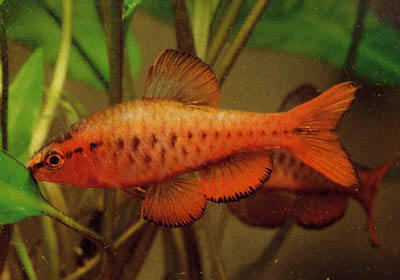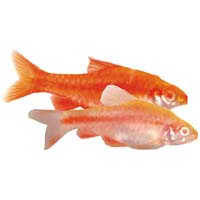| Data Sheet | | |
| Scientific Name: | Barbus Titteya | |
| Family: | Cyprinidae | |
| Origin: | Sri Lanka | |
| Adult Size: | 2 inch (5 cm) | |
| Social: | Friendly fish that get along well with other peaceful fish | |
| Lifespan: | 5 years | |
| Tank Level: | All over | |
| Minimum Tank Size: | 5 gallons | |
| Diet: | Omnivore | |
| Breeding: | Egglayer | |
| Care: | Easy | |
| Ideal pH: | 6.8-7.5 | |
| Temperature: | 72-79 F (22-26 C) | |
| Tank setup:
| Planted Tank with plenty of cover and some open swimming space. |
|
| Sexing: | The male is a bright red color when mating. Females tends to be pink-brown color. | |
| | Description:The Cherry Barb (Barbus titteya Deraniyagala, 1929) is a tropical fish belonging to the Barb family (Cyprinidae). Originating in Sri Lanka, this peaceful cherry-red fish is mostly found in community tanks by fish keeping hobbyists. It will grow in length up to 2 inches (5 centimetres). The Cherry Barb is less of a schooling fish than other Barbs and should best be kept in pairs. Habitat/Care:Cherry Barbs prefer a well planted environment with rocks and driftwood but still need plenty of space to school. Its native environment is one of heavily shaded, shallow, and calm waters. Their native substrate is one of silt with leaf cover. Cherry Barbs are an easy fish to care for. They do not need special attention, and are rather hardy. They should be kept in water with a temperature range form 76 to 80 degrees Fahrenheit. The pH level of the water should be neutral, with a range from 6.6 to 7.2. Mixing with other fishes:Cherry Barbs are peaceful fish that can be mixed with most other peaceful fish of similar size. Diet:Cherry Barbs are omnivores, and can be fed the standard fish foods, worms (glass, blood and tubifex), brine shrimp, plankton, flake and freeze dried foods. They should also be fed various green vegetables, such as spinach, zucchini, peas and lettuce. |
Breeding:When spawning, the male will grow a little larger and become more full bodied. The male Cherry Barb will also be a brighter red when breeding. Cherry Barbs will scatter their eggs, which will number at around 300. After spawning, the parents should be removed from the tank as the parents will eat any eggs they found . The eggs should hatch after about two days, and the fry should be fed prepared fry food, strained boiled egg yolks, baby brine, or microworms. | |
Photo Galley
Got a photo? Contact me.
 |  |  |
| | | |
 |  |  |
| | | |
References Cited:
1. Cherry Barb http://en.wikipedia.org/wiki/Cherry_Barb
2 Cherry Barb http://www.centralpets.com/animals/fish/freshwater_fish/fwf4479.html
3. Cherry Barb Profile http://www.aquatic-hobbyist.com/profiles/freshwater/cyprinids/cherry.html



























No comments:
Post a Comment